A sump pump is installed in order to pump the water that has accumulated in the sump pump basin beneath a basement floor, before the water level rises and overflows. A sump pump check valve is installed to protect the pump and increase pumping efficiency, reduce power consumption and prolong the life of your pump.
In this blog, we will explore the job of a sump pump check valve and the importance of installing one to eliminate sump pump short cycles that could lead to premature pump failures. Let's take a look.
What is a Sump Pump Check Valve?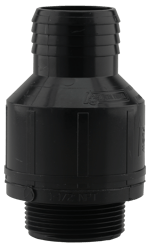
A sump pump check valve is a one way, flapper/swing type valve. They are installed in the discharge pipe from the sump pump. The flapper opens by the force of the water when the pump starts and closes by the force of gravity on the water pushing down on the flapper when the pump stops.
There are two basic types of swing sump pump check valves; gravity closing and spring assisted closing, also referred to as "quiet" or "silent" check.
Gravity Closing (Flat Seat)
Flat seat valves tend to make a loud, clunking noise, caused by water hammer. The flapper has the greatest distance to travel to the fully closed position, resulting in the water gaining momentum before the flapper fully closes. The impact of the flapper hitting the valve seat cause water hammer.
 Gravity Closing (Angled Seat)
Gravity Closing (Angled Seat)
Angled seat swing valves will reduce the water hammer noise to some degree. The angle seat reduces the distance the flapper must travel, to the fully closed position, resulting in the water gaining less momentum before the flapper fully closes. The impact of the flapper hitting the valve seat is reduced and the effects of water hammer are not as noticeable. 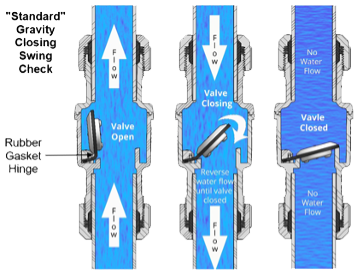
Spring Assist Closing (Quiet or Silent)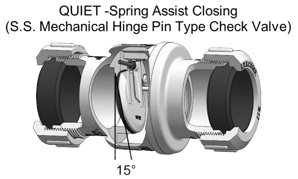
As mentioned, these valves are referred to as "quiet" or "silent" check valves as they eliminate the clunking noise. The spring applies low force on the flapper against the water flowing through the valve. As the water slows, the pump shuts off and the spring softly closes the valve against the seat. Since there is no flow reversal, the flapper does not impact the valve seat, eliminating any effects due to water hammer.
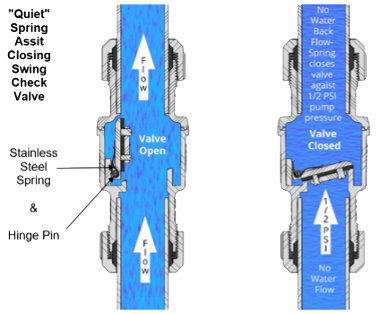
Why Install a Sump Pump Check Valve?
Pumping Efficiency
When the float switch signals the pump to start, it forces the pump to push water through the valve, and out through the discharge pipe. When the water level drops, the float switch signals the pump to stop, stopping the water. Gravity then causes the water that is in the discharge pipe to drain back into the pit.
The check valve is there to prevent the pump from having to re-pump that volume of water over again. Eliminating this issue will save on electricity costs.
Pump Protection
Short cycling of a sump means that the pump turns on and off too quickly or too frequently. Short cycling causes the pump motor to run hotter. Heat is an enemy of electric motors and can shorten the life of a sump pump significantly. By installing a check valve, it will reduce the risk of short cycling, especially in smaller size sump basins. A check valve will extend the life of the sump pump, and save you money.
Location
The most suitable location for a sump pump check valve is between 8" up from the pumps discharge to approximately 12" above floor level. Installation above the floor level is convenient for easy inspection, servicing, or replacement of the valve. You want to install a check valve 6" above the pump discharge when installed down inside the sump basin to allow for the drilling of air release or weep holes to protect against air lock for sump pumps that do not have a built-in air lock prevention system.
Always refer to the sump pump manufacturers installation instructions.
Installing the sump check valve down in the sump basin below the cover can reduce the noise caused by water hammer if a standard gravity closing valve is installed, however, making inspections and servicing is not not nearly as convenient.
Improper Installation or Not Installing one at all
Not having a sump pump check valve installed causes the water in the discharge pipe to empty back into the sump pump pit. This makes the water level in the sump pit rise and a high water level can cause the pump to run more often, increasing your energy costs.
If the check valve is installed in the incorrect spot such as too high up on the discharge pipe, the pump will empty the pit during the run cycle but when it shuts off, the water below the check valve will drain back into the basin causing the water level to rise very quickly. When that happens, it will trigger the float switch to start the pump again right away, eventually wearing out your pump prematurely.
Sump pump check valves are available in three basic types, shown in the pictures below. Each type is available in a variety of sizes and connection types.
This article will assist you in the selection process, helping you determine which valve is best suited for your application.
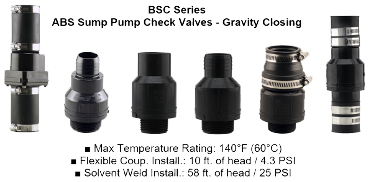
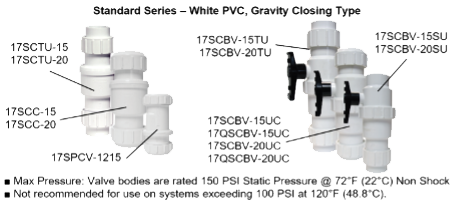

ABS Sump Pump Check Valve
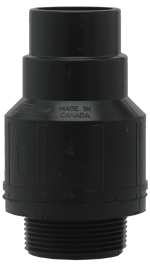 This style of sump pump check valve has a 15° seat that reduces any noise caused by water hammer. It is created with a one piece flapper which ensures a positive seal. This style of check valve is a very universal sump pump check valve. It can be installed in multiple different ways:
This style of sump pump check valve has a 15° seat that reduces any noise caused by water hammer. It is created with a one piece flapper which ensures a positive seal. This style of check valve is a very universal sump pump check valve. It can be installed in multiple different ways:
- With a 1-1/4" polyethylene pipe by clamping the pipe over the barbed end of the valve.
- With a 1-1/2" Sch 40 PVC pipe by gluing a coupling directly to the valve right after the barb part of the check valve.
- With 1-1/4" corrugated hose by clamping the hose over the barbed section of the check valve.
- With 1-14" Sch 40 PVC pipe with the use of any 1-1/2" x 1-1/4" reducing bushing and 1-1/2" deep coupling.
Air Release Hole
 An air release hole is also referred to as a weep hole or air vent. This hole is typically drilled in the discharge pipe approximately 5" above the pump discharge connection and below the check valve by the installer. The purpose of the air release hole is to provide a passage way to allow the air to exit that normally gets
An air release hole is also referred to as a weep hole or air vent. This hole is typically drilled in the discharge pipe approximately 5" above the pump discharge connection and below the check valve by the installer. The purpose of the air release hole is to provide a passage way to allow the air to exit that normally gets trapped in the sump pump housing, preventing the pump from removing water from the pit.
trapped in the sump pump housing, preventing the pump from removing water from the pit.
Any check valves with a MPT (Male Pipe Thread) connection that are designed to thread directly to the sump pump discharge housing must have the air release hole drilled into the check valve body directly above the MPT connection and below the flapper. Having an air release valve with the moulded-in hole eliminates the time and expense of drilling at the time of installation.
Installing a sump pump check valve is critical, but it is also extremely important to ensure it is being properly installed in the correct location. Be sure to keep in mind pump efficiency, pump protection and location when you go to install a sump pump check valve. Proper installation the first time will save you time and money.
Have further questions about this subject?

Head over to Boshart's Knowledge Base: technical product information, guidelines, and more.





SHARE